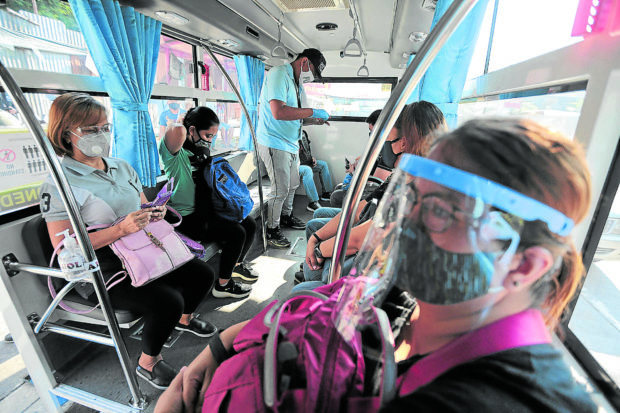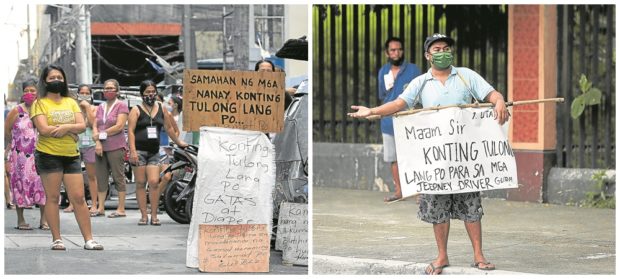Jeepney, UV Express drivers: We need work

NEW JEEPNEY Passengers on an air-conditoned jeepney plying the Roces-Cubao route in Quezon City maintain physical distancing, as only 13 people are allowed on the vehicle in line with safety regulations amid the coronavirus pandemic. —GRIG C. MONTEGRANDE
MANILA, Philippines — Drivers and operators of UV Express vehicles and conventional jeepneys are appealing to transport authorities to allow them to return to the streets of Metro Manila, saying their fleets are more than ready to resume operations as they also need work “to live.”
“We are so disappointed that we cannot resume operations despite the fact that we are very much ready to observe the protocols set by the government,” Rosalino Marable, president of Coalition of Operators and Drivers of UV Express Atbp. (Codex), said on Monday.
Marable said Codex members were raring to go back to work because “they are already crying out of hunger. They want to go back to driving because they were piling up debts for three months.”
The transport group Piston said hundreds of thousands of commuters in the streets would need conventional jeepneys to get to their places.
“Jeepney drivers also need them to live,” Piston national president emeritus George San Mateo said on Monday.
Article continues after this advertisementHe noted that the currently running public utility vehicles and other forms of mass transportation were not enough to meet demand.
Article continues after this advertisement“The 65,000 conventional jeepneys are ready to serve anytime and just waiting for the government,” he added.
Presidential spokesperson Harry Roque said the fate of traditional jeepneys would depend on whether the buses, modern jeepneys and taxis allowed to operate ahead of them would be adequate for commuters.
At a press briefing, Roque said the government was still studying whether to allow the conventional jeepneys back on the road as it claimed that physical distancing would be difficult to observe in these vehicles because of the longitudinal seating.
San Mateo of Piston, however, said physical distancing could be observed by putting up plastic barriers between passengers, which he noted were a strategy devised by conventional jeepneys and later on adopted by the government for modern jeepneys.
The administration has been trying for years to implement its controversial jeepney modernization program, under which the old models would be replaced with modern ones.
On Monday, 308 modern jeepneys and 2,600 buses resumed operations in Metro Manila. The capital region has been under general community quarantine (GCQ) since June 1, under which more businesses have been allowed to reopen to revive the economy.
More taxis, TNVS units
Nearly 2,000 more taxis and ride-hailing service vehicles also hit the road as part of the Land Transportation Franchising and Regulatory Board’s (LTFRB) gradual restoration of prepandemic normality in Metro Manila.
The LTFRB said more than 1,900 taxis and transport network vehicle services (TNVS) like Grab were back on the road, bringing to 41,639 the total number of such vehicles it had approved to ferry passengers as the capital emerged from quarantine. Of the total, 22,230 were TNVS units and 19,409 were taxis.
Taxis and TNVS units were among the first forms of public transportation to be allowed to operate when the metropolis transitioned into GCQ. An initial 23,067 units were permitted to run.
The taxis and TNVS units, however, have not prevented chaos from erupting in various pockets of the capital at the start of the month, especially as cheaper and more spacious forms of transportation like jeepneys and UV Express vehicles were still prohibited.
Private-vehicle oriented
Transport agencies have long been criticized by commuter groups and other advocacy organizations for directing its policy focus on private vehicles—which still remain largely inaccessible to swaths of the urban population—instead of beefing up bike lanes or mass transport options.
Sen. Grace Poe, Senate public services committee chair, said transportation officials should come up with a “data-driven assessment” of the expected increase in demand for public transportation in the coming days.
Back ‘within the month’
She said workers should not spend their hard-earned income to pay for more expensive mode of transportation.
The LTFRB gave assurance that UV Express vans would be back “within the month,” along with conventional jeepneys, to cater to the growing number of commuters returning to work as industries had reopened under GCQ.
But UV Express vehicles will be only “point-to-point,” doing away with the previous practice of picking up and dropping off passengers anywhere along their routes.
The Department of Transportation and LTFRB belatedly announced on Sunday that UV Express vans were not allowed yet in the metropolis as guidelines for their operation were still being prepared by the technical working group.

NEEDING HELP In this May 21 photo (left), women residents of Barangay 210 in Tondo, Manila, gather on Rizal Avenue to seek assistance for their families. Jeepney drivers displaced by the quarantine (right photo) flag motorists for help on C.P. Garcia Avenue in Quezon City on Monday. —PHOTOS BY LYN RILLON AND GRIG C. MONTEGRANDE
Marable of Codex said he was informed only on Saturday that his group’s units were not yet allowed to service passengers right after a TV interview when he said all their systems were ready for their supposed return on June 22.
He said his group was more than prepared for any changes on routes but was puzzled on what was taking authorities so long to finish them. Before the pandemic, more than 9,000 franchised UV Express vehicles were serving more than 200 routes in Metro Manila.
Codex members, according to Marable, have put in place measures to assure the health and safety of passengers.
Upon passengers’ entry at the terminal, they would be checked with a thermal scanner. They would also need to fill out a form for contact-tracing purposes.
Marable said transactions would still be cash-based but someone would be assigned exclusively to collect fares and to give passengers boarding passes.
Passengers would be asked to disinfect with alcohol and foot baths, and upon boarding would be seated only on marked seats to comply with the 50-percent capacity requirement for physical distancing.
—With a report from Marlon Ramos
For more news about the novel coronavirus click here.
What you need to know about Coronavirus.
For more information on COVID-19, call the DOH Hotline: (02) 86517800 local 1149/1150.
The Inquirer Foundation supports our healthcare frontliners and is still accepting cash donations to be deposited at Banco de Oro (BDO) current account #007960018860 or donate through PayMaya using this link.